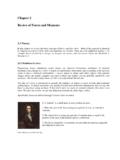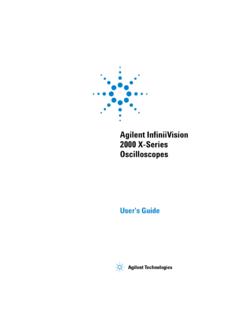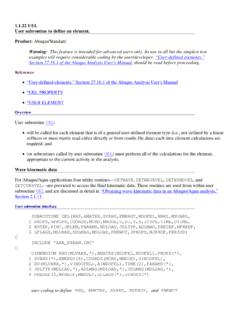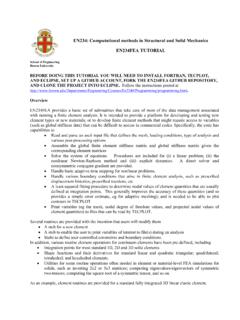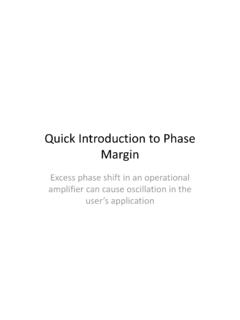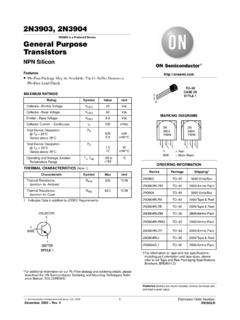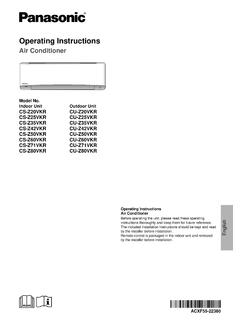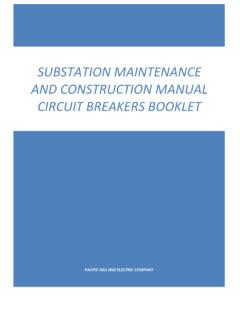Transcription of www.siemens.com/energy/hvdc High Voltage Direct Current ...
1 Answers for Voltage Direct Current Transmission Proven Technology for Power Theme Page1 Why High Voltage Direct Current ? 42 Main Types of HVDC Schemes 63 Converter Theory 84 Principle Arrangement of an HVDC Transmission Project 115 Main Components Thyristor Valves Converter Transformer Smoothing Reactor Harmonic Filters AC Harmonic Filter DC Harmonic Filter Active Harmonic Filter Surge Arrester DC Transmission Circuit DC Transmission Line DC Cable High Speed DC Switches Earth Electrode Control & Protection 386 System Studies, Digital Models, Design Specifications 457 Project Management 4631 Why High Voltage Direct Current ? Highlights from the High Voltage Direct Current (HVDC) HistoryThe transmission and distribution of electrical energy started with Direct Current .
2 In 1882, a 50-km-long 2-kV DC transmission line was built between Miesbach and Munich in Germany. At that time, conversion between reasonable consumer voltages and higher DC transmission voltages could only be realized by means of rotating DC an AC system, Voltage conversion is simple. An AC transformer allows high power levels and high insulation levels within one unit, and has low losses. It is a relatively simple device, which requires little maintenance. Further, a three-phase synchronous generator is superior to a DC generator in every respect. For these reasons, AC technology was introduced at a very early stage in the develop-ment of electrical power systems. It was soon accepted as the only feasible technology for genera-tion, transmission and distribution of electrical , high- Voltage AC transmission links have disadvantages, which may compel a change to DC technology: Inductive and capacitive elements of overhead lines and cables put limits to the transmission capacity and the transmission distance of AC transmission links.
3 This limitation is of particular significance for cables. Depending on the required transmission capacity, the system frequency and the loss evalua-tion, the achievable transmission distance for an AC cable will be in the range of 40 to 100 km. It will mainly be limited by the charging Current . Direct connection between two AC systems with different frequencies is not possible. Direct connection between two AC systems with the same frequency or a new connection within a meshed grid may be impossible because of system instability, too high short-circuit levels or undesir-able power flow were therefore engaged over generations in the development of a technology for DC transmis-sions as a supplement to the AC transmissions. Line-Commutated Current Sourced ConvertersThe invention of mercury arc rectifiers in the nine-teen-thirties made the design of line-commutated Current sourced converters 1941, the first contract for a commercial HVDC system was signed in Germany: 60 MW were to be supplied to the city of Berlin via an underground cable of 115 km length.
4 The system with 200 kV and 150 A was ready for energizing in 1945. It was never put into operation. Since then, several large HVDC systems have been realized with mercury arc replacement of mercury arc valves by thyristor valves was the next major development. The first thyristor valves were put into operation in the late nineteen-seventies. The outdoor valves for Cahora Bassa were designed with oil-immersed thyristors with parallel/series connection of thyristors and an electromagnetic firing development went via air-insulated air- cooled valves to the air- insulated water-cooled design, which is still state of the art in HVDC valve development of thyristors with higher Current and Voltage ratings has eliminated the need for parallel connection and reduced the number of series-connected thyristors per valve.
5 The develop-ment of light-triggered thyristors has further reduced the overall number of components and thus contrib-uted to increased in almost every other area of HVDC have been constantly adding to the reliability of this tech-nology with economic benefits for users throughout the Voltage Sourced ConvertersVoltage sourced converters require semiconductor devices with turn-off capability. The development of Insulated Gate Bipolar Transistors (IGBT) with high Voltage ratings have accelerated the development of Voltage sourced converters for HVDC applications in the lower power range. The main characteristics of the Voltage sourced converters are a compact design, four-quadrant operation capability and high losses. Siemens is offering Voltage sourced converters for HVDC applications with ratings up to 250 MW under the trade name HVDC plus Power Link Universal Systems.
6 This paper focuses upon HVDC transmission systems with high ratings, with line-commutated Current sourced converters. HVDC = high Voltage Direct currentDC = Direct Current AC = alternating currentIGBT = insulated gate bipolar Technical Merits of HVDCThe advantages of a DC link over an AC link are: A DC link allows power transmission between AC networks with different frequencies or networks, which can not be synchronized, for other reasons. Inductive and capacitive parameters do not limit the transmission capacity or the maximum length of a DC overhead line or cable. The conductor cross section is fully utilized because there is no skin effect. For a long cable connection, beyond 40 km, HVDC will in most cases offer the only technical solution because of the high charging Current of an AC cable.
7 This is of particular interest for trans-mission across open sea or into large cities where a DC cable may provide the only possible solution. A digital control system provides accurate and fast control of the active power flow. Fast modulation of DC transmission power can be used to damp power oscillations in an AC grid and thus improve the system Economic ConsiderationsFor a given transmission task, feasibility studies are carried out before the final decision on imple-mentation of an HVAC or HVDC system can be taken. shows a typical cost comparison curve between AC and DC transmission considering: AC vs. DC station terminal costs AC vs. DC line costs AC vs. DC capitalised value of lossesThe DC curve is not as steep as the AC curve because of considerably lower line costs per kilometre.
8 For long AC lines the cost of intermediate reactive power compensation has to be taken into break-even distance is in the range of 500 to 800 km depending on a number of other factors, like country-specific cost elements, interest rates for project financing, loss evaluation, cost of right of way Environmental IssuesAn HVDC transmission system is basically environment-friendly because improved energy transmission possi-bilities contribute to a more efficient utilization of existing power plants. The land coverage and the associated right-of-way cost for an HVDC overhead transmission line is not as high as that of an AC line. This reduces the visual impact and saves land compensation for new projects. It is also possible to increase the power transmission capacity for existing rights of way.
9 A comparison between a DC and an AC overhead line is shown in Fig. 1-2: Typical transmission line structures for approx. 1000 MWThere are, however, some environmental issues which must be considered for the converter stations. The most important ones are: Audible noise Visual impact Electromagnetic compatibility Use of ground or sea return path in monopolar operation In general, it can be said that an HVDC system is highly compatible with any environment and can be integrated into it without the need to compromise on any environmentally important issues of 1-1: Total cost/distanceCostsTotal AC CostTotal DC CostDC LineDC TerminalsDC LossesAC LossesAC LineAC TerminalsBreak-Even DistanceTransmissionDistance2 Main Types of HVDC DC CircuitThe main types of HVDC converters are distinguished by their DC circuit arrange-ments.
10 The following equivalent circuit is a simplified representation of the DC circuit of an HVDC 2-1: Equivalent DC circuitThe Current , and thus the power flow, is controlled by means of the difference between the controlled voltages. The Current direction is fixed and the power direction is controlled by means of the Voltage polarity. The converter is described in the next section. Back-to-Back ConvertersThe expression Back-to-back indicates that the recti-fier and inverter are located in the same converters are mainly used for power transmission between adjacent AC grids which can not be synchronized. They can also be used within a meshed grid in order to achieve a defined power AC System 1AC System 2 Fig. 2-2: Back-to-back converterHVDC = high Voltage Direct currentDC = Direct Current AC = alternating currentUd = DC Voltage 12-pulseId = DC currentOHL = overhead lineLVDC = low Voltage Direct currentFig.
